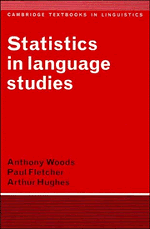Book contents
- Frontmatter
- Contents
- Preface
- 1 Why do linguists need statistics?
- 2 Tables and graphs
- 3 Summary measures
- 4 Statistical inference
- 5 Probability
- 6 Modelling statistical populations
- 7 Estimating from samples
- 8 Testing hypotheses about population values
- 9 Testing the fit of models to data
- 10 Measuring the degree of interdependence between two variables
- 11 Testing for differences between two populations
- 12 Analysis of variance – ANOVA
- 13 Linear regression
- 14 Searching for groups and clusters
- 15 Principal components analysis and factor analysis
- Appendix A Statistical tables
- Appendix B Statistical computation
- Appendix C Answers to some of the exercises
- References
- Index
Appendix B - Statistical computation
Published online by Cambridge University Press: 05 June 2012
- Frontmatter
- Contents
- Preface
- 1 Why do linguists need statistics?
- 2 Tables and graphs
- 3 Summary measures
- 4 Statistical inference
- 5 Probability
- 6 Modelling statistical populations
- 7 Estimating from samples
- 8 Testing hypotheses about population values
- 9 Testing the fit of models to data
- 10 Measuring the degree of interdependence between two variables
- 11 Testing for differences between two populations
- 12 Analysis of variance – ANOVA
- 13 Linear regression
- 14 Searching for groups and clusters
- 15 Principal components analysis and factor analysis
- Appendix A Statistical tables
- Appendix B Statistical computation
- Appendix C Answers to some of the exercises
- References
- Index
Summary
Calculators
Most of the measures, estimators and test statistics discussed in the first thirteen chapters of the book can be obtained from data by the use of a modest electronic calculator costing less than £20. To be at all useful a calculator must have the following features: (a) an automatic square root function (key usually marked ‘√’); (b) at least two memories. It is certainly worthwhile to buy a calculator which has some built-in statistical calculations. Most calculators now have a facility to calculate the mean and variance of a single data set. Many will also calculate correlations (look for the letter ‘r’ – usually to be found in a different colour beside one of the keys rather than on it) and simple linear regressions.
Using a computer
However, throughout the book it has been assumed that, except where the calculations are simple and straightforward, the analysis will be carried out using a suitable computer package. There are several stages involved in that process. The data have to be put in an appropriate form and possibly stored in advance, the analysis carried out and the results printed on paper so that they can be studied carefully at leisure. It will be assumed in what follows that the analysis is to be carried out on a moderately large computing facility accessed via a terminal (or remote terminal) which is not an integral part of the computer. It is possible that you may have access to a microcomputer which has a program for analysing statistical data.
- Type
- Chapter
- Information
- Statistics in Language Studies , pp. 307 - 313Publisher: Cambridge University PressPrint publication year: 1986



